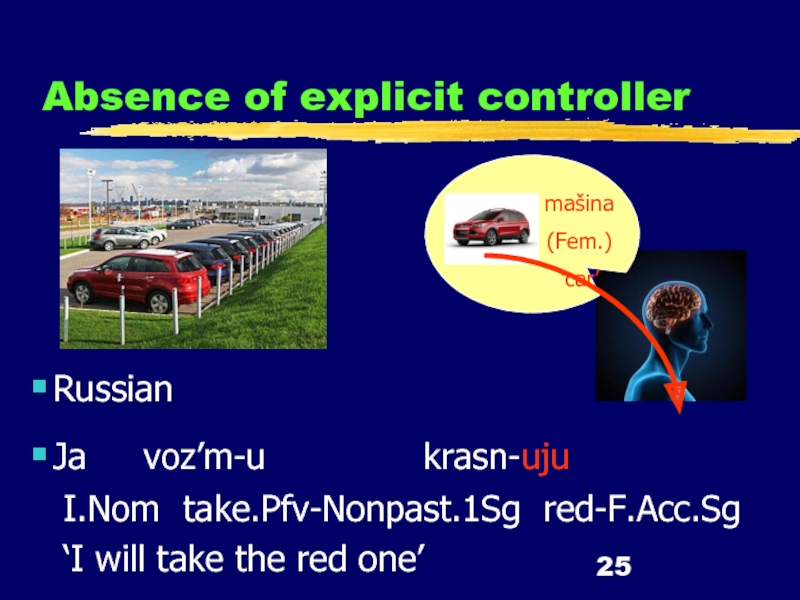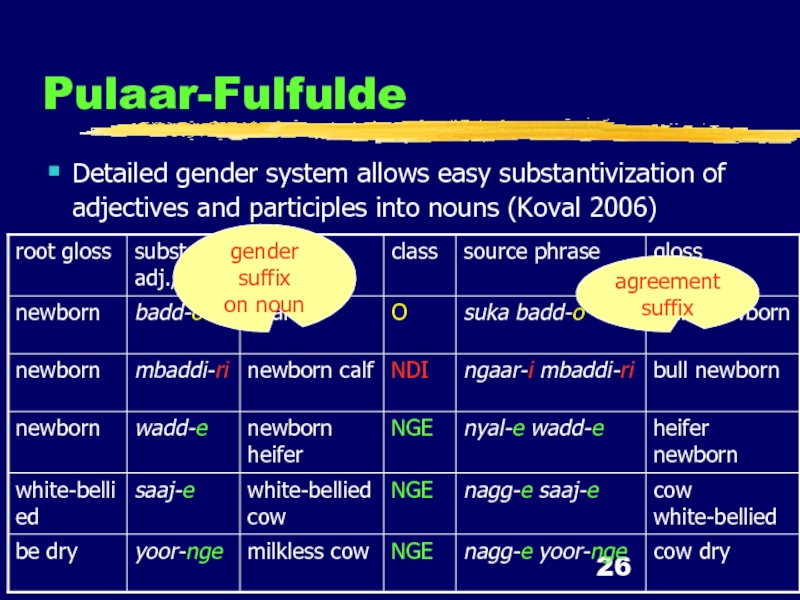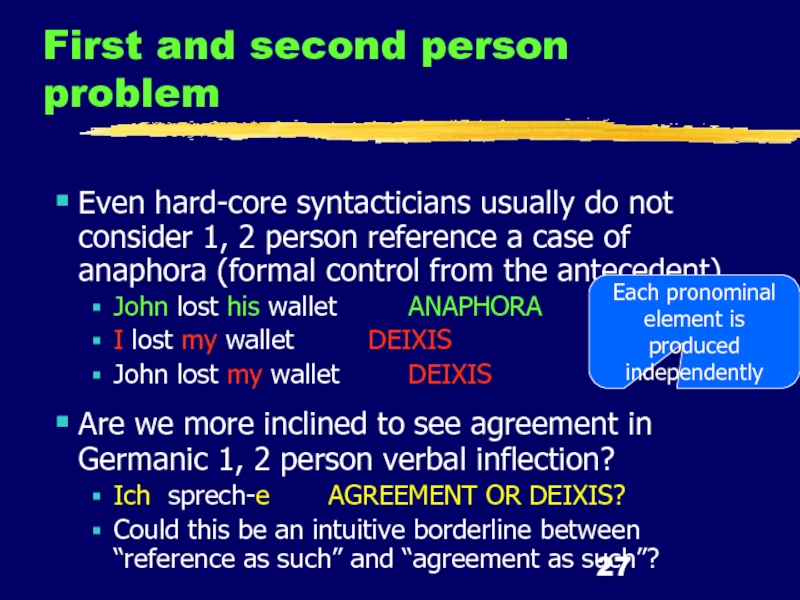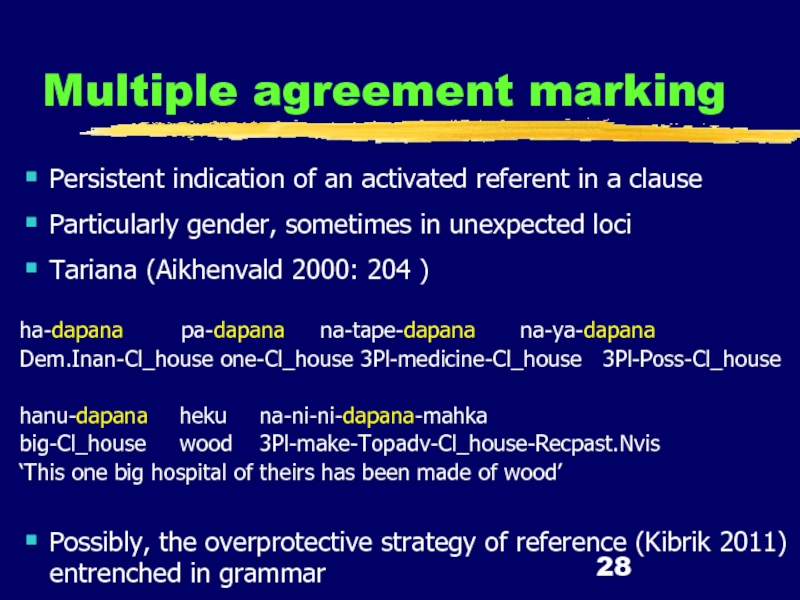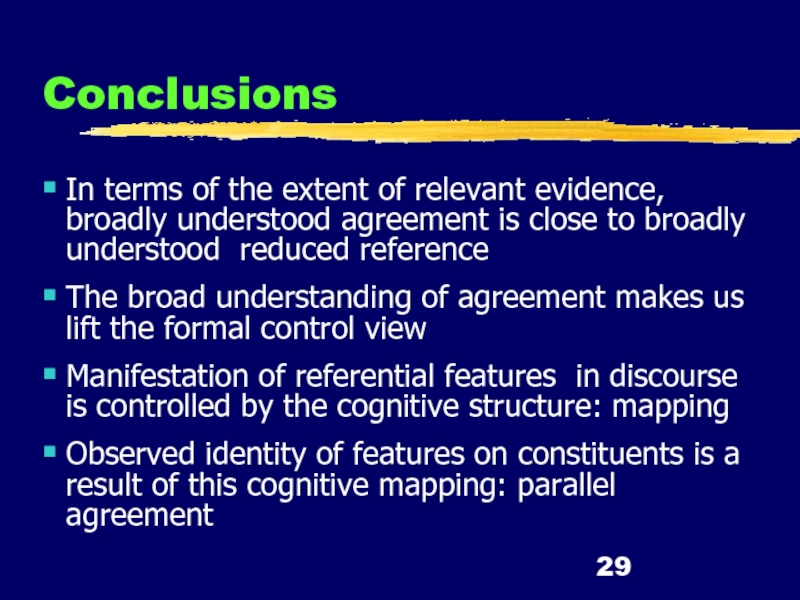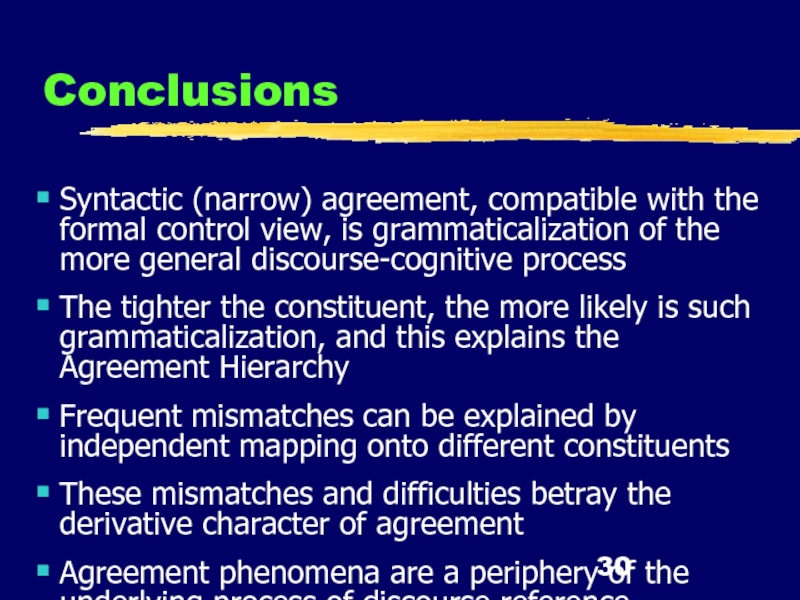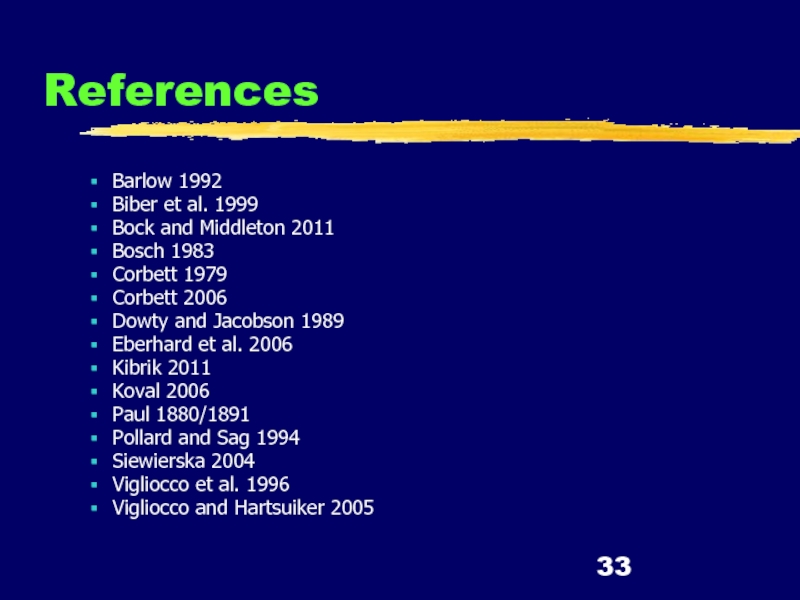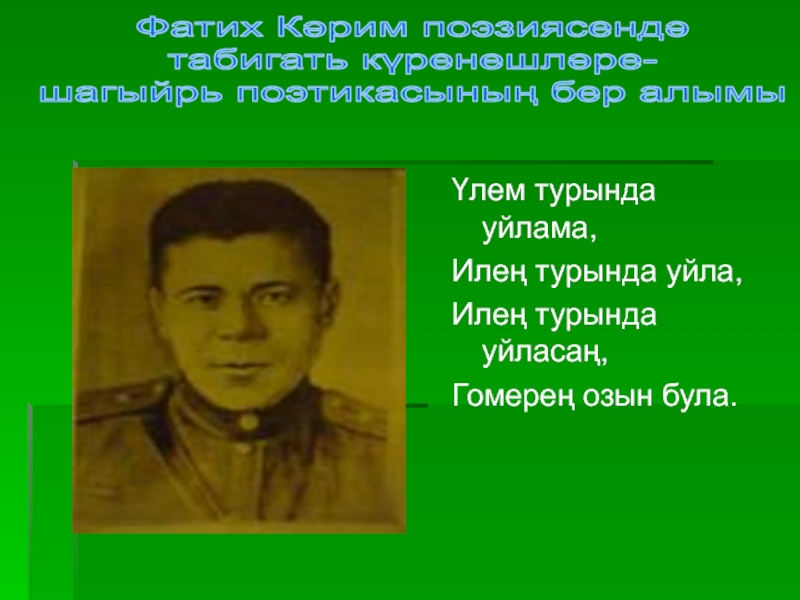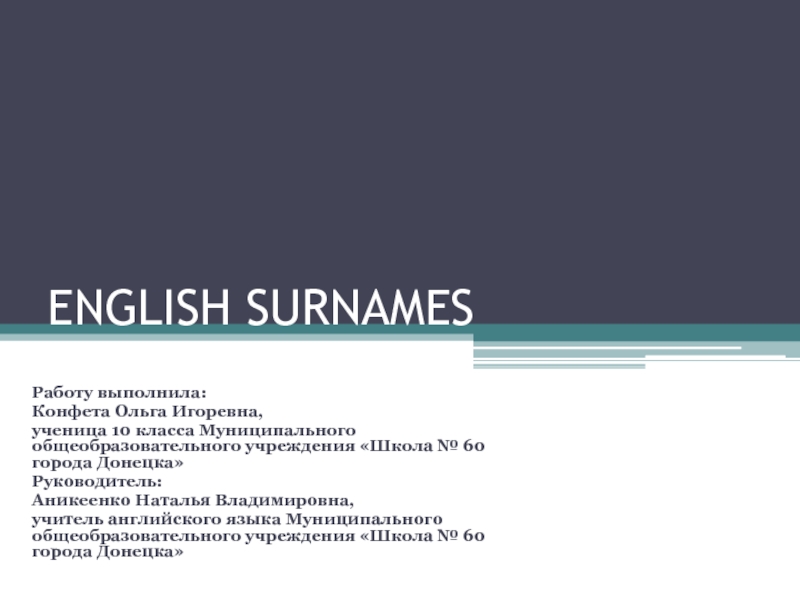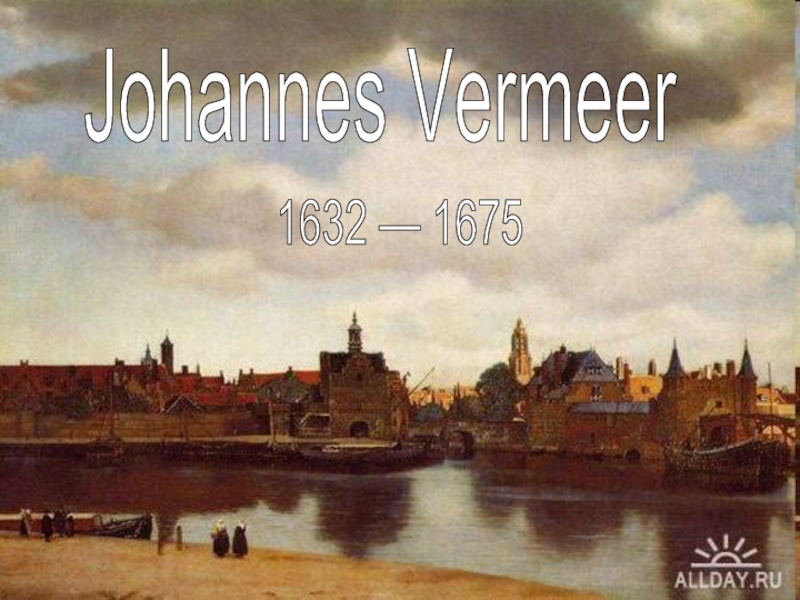Разделы презентаций
- Разное
- Английский язык
- Астрономия
- Алгебра
- Биология
- География
- Геометрия
- Детские презентации
- Информатика
- История
- Литература
- Математика
- Медицина
- Менеджмент
- Музыка
- МХК
- Немецкий язык
- ОБЖ
- Обществознание
- Окружающий мир
- Педагогика
- Русский язык
- Технология
- Физика
- Философия
- Химия
- Шаблоны, картинки для презентаций
- Экология
- Экономика
- Юриспруденция
Agreement in cognition, discourse, and syntax
Содержание
- 1. Agreement in cognition, discourse, and syntax
- 2. Strangeness of agreementDoes this resemble the common linguistic understanding of the term “agreement”?
- 3. Agreement as formal control“There is a strong
- 4. Origin of the dominant linguistic usageHermann Paul,
- 5. Formal control agreement is derivative from parallel
- 6. Formal control agreement terminology in Paul 1880 ”Namentlich
- 7. Formal control-style understanding of agreementFormal control-style understanding
- 8. Agreement and referenceAgreement has much in common
- 9. Terminology (person agreement)broader agreementbroadest agreement
- 10. Terminology (person agreement)reduced referenceextended reduced reference
- 11. Reduced reference and agreementIn the broadest understanding
- 12. Reference: the process of mentioning mental entities
- 13. Referential choiceActivation in working memory => reduced
- 14. Syntactic anaphora?Reference and referential choice are fundamentally
- 15. Discourse use of broader agreement (bound pronouns)Latin
- 16. Polypersonal broader agreement (Navajo)wónáásóó shį́į́ bimá hadah ha-b-í-ˀ-ch’-íí-yil
- 17. Broader agreementClearly the same principles of operation
- 18. Cooccurrence does not mean cause-effect or control relationship Controller-target relationship?
- 19. Narrow agreementSuch as Germanic verbal person agreementClearly
- 20. Formal control view of agreementCONTROLLER TARGETart nouveausie kommen?? ??? rogabat person number gender ………
- 21. Discourse-based, parallel agreementRart nouveausie kommenquaerebat rogabat person number gender ………
- 22. Grammaticalization of discourse-based agreementRCONTROLLER TARGETart nouveausie kommen rogabat person number gender ………
- 23. DisagreementBut even in the narrow agreement there
- 24. InconsistencyTurkic person agreementTuvan [men] keldim I comePast1Sg ‘I came’[men] kelgen=men I comePf=1Sg ‘I have come’
- 25. Absence of explicit controllerRussianJa voz’m-u krasn-uju I.Nom take.Pfv-Nonpast.1Sg red-F.Acc.Sg ‘I will take the red one’mašina(Fem.)‘car’
- 26. Pulaar-FulfuldeDetailed gender system allows easy substantivization of
- 27. First and second person problemEven hard-core syntacticians
- 28. Multiple agreement markingPersistent indication of an activated
- 29. ConclusionsIn terms of the extent of relevant
- 30. ConclusionsSyntactic (narrow) agreement, compatible with the formal
- 31. AcknowledgementsMira BergelsonOlga FedorovaDiana ForkerGeoffrey HaigAntonina KovalHermann Paul
- 32. Thank you for your attention
- 33. ReferencesBarlow 1992Biber et al. 1999Bock and Middleton
- 34. Скачать презентанцию
Слайды и текст этой презентации
Слайд 1Agreement in cognition,
discourse, and syntax
Bamberg,
February 1, 2013
Andrej A. Kibrik
(Institute
of Linguistics RAN
Слайд 2Strangeness of agreement
Does this resemble the common linguistic understanding of
the term “agreement”?
Слайд 3Agreement as formal control
“There is a strong intuition, captured
in the controller-target terminology, that agreement is asymmetric” (Corbett 2006:
115)Psycholinguistics: inflectional or control theory of agreement
Слайд 4Origin of the dominant linguistic usage
Hermann Paul, 1880
Prinzipien der
Sprachgeschichte,
chapter “On concord”
“die Tendenz Wörter, die in einer Beziehung
zueinander stehen <…> in formelle Übereinstimmung miteinander zu setzen. Hierher gehört die Kongruenz in Genus, Numerus, Kasus, Person, wie sie zwischen einem Subst. und einem dazu gehörigen Präd. oder Attribut oder einem dasselbe vertretenden Pron. oder Adj. besteht <…> ”Principles of the
history of language,
edition 1891
“There exists a tendency to place words related in a way <…> in formal correspondence with each other. Thus is explained the concord in gender, number, case, and person, which subsists between a substantive and its predicate or attribute, or a pronoun or adjective representing the latter <…>”
Слайд 5Formal control agreement is derivative from parallel agreement
”Den Ausgangspunkt für
die Entstehung der Kongruenz haben solche Fälle gebildet, in denen
die formelle Übereinstimmung eines Wortes mit einem andern nicht durch Rücksichtnahme auf dasselbe herbeigeführt, sondern nur durch die Gleichheit der Beziehung bedingt ist.”“The starting-point for the origin of concord was afforded by cases in which the formal correspondence of a word with another was produced not by any regard for the latter, but merely by the identity of their relation.”
Слайд 6Formal control agreement terminology in Paul 1880
”Namentlich entsteht eine Verlegenheit
des Sprechenden da, wo eine grammatische Kongruenz zwischen zwei Satzteilen
dem Sinne nach nicht möglich ist und dazu ein dritter Satzteil tritt, von dem man gewohnt ist, dass er mit beiden kongruiert. Man muss sich für einen von den beiden entscheiden <…>”“The speaker is especially apt to feel perplexity in cases where a grammatical concord is from the sense impossible, and a third clause comes in which custom has led us to expect to agree with both. We have to decide in favor of one or the other <…>”
It was my orders
Das sind zwei verschiedene Dinge.”
Слайд 7Formal control-style understanding of agreement
Formal control-style understanding dominates in modern
linguistics and psycholinguistics
This has a consequence: desire to narrow down
the notion of agreementKibrik 2011 – narrow, syntactic understanding of agreement
In the domain of argument-predicate agreement, primarily the Germanic pattern, most remote from discourse reference
However, in the context of this workshop I allow a broader, discourse-oriented understanding of the term “agreement”
In order to do that we will need to lift the formal-control requirement towards agreement
Слайд 8Agreement and reference
Agreement has much in common with reduced reference
Person
agreement on the verb goes back to reduced reference (pronouns)
(Paul 1880/1891: 348-349; Siewierska 2004)The same often applies to attributive agreement
Russian
bel-yj < běl-ъ=jь lit. ‘white he’
white-M.Sg.Nom white-M.Sg.Nom=3M.Sg.Nom
bel-aja < běl-a=ja lit. ‘white she’
white-F.Sg.Nom white-F.Sg.Nom=3F.Sg.Nom
Classic agreement features are all referential: person, number, gender
Слайд 11Reduced reference and agreement
In the broadest understanding of both, the
extent of the included phenomena may almost coincide
There are some
unusual agreement features (see Corbett 2006 on tense agreement, also cf. Paul 1880), but let us focus on major featuresBut the notions still remain distinct
Reduced reference is a functional notion: the process of rendering activated referents in discourse
Agreement is a linguist’s observation about the covariance of discourse constituents
Слайд 12Reference: the process of mentioning mental entities (referents) in discourse
by means of referential expressions
The Victorian house that Ms. Johnson
is inspecting has been deemed unsafe by town officials. But she asks a workman toting the bricks from the lawn to give her a boost through an open first-floor window. Once inside, she spends nearly four hours Ø measuring and diagramming each room in the 80-year-old house, Ø gathering enough information to Ø estimate what it would cost to rebuild it. She snaps photos of the buckled floors and the plaster that has fallen away from the walls.Слайд 13Referential choice
Activation in working memory => reduced referential device. Else
use a full device
E.g. if the referent ‘Ms. Johnson’ is
highly activated, use a pronounHow are different referential expressions, such as the eight mentions of ‘Ms. Johnson’, related to each other?
Clearly no formal control (different syntactic domains)
One can speak about agreement between them (in person, number, gender), but
such agreement is clearly an epiphenomenon of the individual mappings “referent → referential expression”
referential expressions just happen to be in agreement or concord with each other
Слайд 14Syntactic anaphora?
Reference and referential choice are fundamentally discourse-based, cognitively-driven processes
Is
there something like syntactic anaphora?
A mother and her child NP
I gave
John his ticket ClauseI promised John to give him his ticket Closely connected clauses
To account for such syntactic usages, one can still employ a full-scale cognitively based explanation
But it may be sometimes more economical to account for syntactic usages with the help of simple and automatic rules
Including in terms of formal control from the antecedent
Antecedent functions as a placeholder, formal representative of the usual cognitive controller
Syntactic anaphora is grammaticalization or routinization of the more general process of discourse-based reduced reference
Слайд 15Discourse use of broader agreement (bound pronouns)
Latin (Horace, Satires 1.5:
65 ff.)
Cicirrus, Sarmentus
rogaba-t denique cur umquam fugisse-t,
ask.Impf-3Sg finally why sometime flee.Plpf.Conj-3Sg
cui satis una farr-is libra fore-t,
who.Dat enough one flour-Gen.Sg pound be.Impf.Conj-
3Sg
‘Finally he [=Cicirrus] asked why he [=
Sarmentus] had ever fled, to whom one pound of flour would have been enough’Bound tenacious pronouns
Слайд 16Polypersonal broader agreement (Navajo)
wónáásóó shį́į́ bimá hadah ha-b-í-ˀ-ch’-íí-yil
finally Ptcl his.mother down up.out-3.Obl-against-
Pref-4.Nom-Pfv-push
‘Finally, it
appears, his mother pushed him out (of the nest)’
ts’ídá shį́į́
naˀahóóhai b-a-ˀ-í-ltsood
just Ptcl chicken 3.Obl-to-Indef.Acc-Pfv-were.fed
‘Probably at that time the chickens were fed’ (lit. ‘ somethingwas fed to the chickens’)
The more a language has of broad agreement, the less that looks like narrow agreement
Слайд 17Broader agreement
Clearly the same principles of operation as in more
familiar reduced reference by free pronouns
Control from the cognitive system
Formal
control treatment is ruled out (distinct syntactic domains)Parallel referential mapping leads to parallel agreement
Related approaches
Agreement and anaphora – Bosch 1983, Barlow 1992
Semantic agreement – Dowty and Jacobson 1989
Constraint approach – Pollard and Sag 1994, Vigliocco et al. 1996, Vigliocco and Hartsuiker 2005
Important terms: unification, reconciliation of features, maximalism, notional agreement
Слайд 18Cooccurrence does not mean cause-effect or control relationship
Controller-target relationship?
Слайд 19Narrow agreement
Such as Germanic verbal person agreement
Clearly related to broad
agreement
Cf. German 3Sg present –t still identical to Latin (cognate)
Can
be viewed as grammaticalization of the discourse pattern (both diachronic and synchronic)The narrower the domain, the more appropriate is the formal control approach
Agreement Hierarchy (Corbett 1979, 2006; cf. Eberhard et al. 2006) attributive > predicate > relative pronoun > personal pronoun
increasing contribution of semantic factors
Слайд 20Formal control view of agreement
CONTROLLER TARGET
art nouveau
sie kommen
?? ??? rogabat
person number gender
………
Слайд 21Discourse-based, parallel agreement
R
art nouveau
sie kommen
quaerebat rogabat
person number gender ………
Слайд 22Grammaticalization of discourse-based agreement
R
CONTROLLER TARGET
art nouveau
sie kommen
rogabat
person number gender ………
Слайд 23Disagreement
But even in the narrow agreement there are multiple difficulties
and mismatches
Because of parallel, independent mapping from the cognitive structure?
Errors
(?)In a conversational corpus I says occurs up to 50% of the time (Biber et al. 1999: 191)
Attraction or proximity effect
the key to the cabinets were missing (Bock and Middleton 2011)
“Committee contexts”
Слайд 24Inconsistency
Turkic person agreement
Tuvan
[men] keldim
I comePast1Sg
‘I came’
[men] kelgen=men
I comePf=1Sg
‘I have come’
Слайд 25Absence of explicit controller
Russian
Ja voz’m-u krasn-uju
I.Nom take.Pfv-Nonpast.1Sg red-F.Acc.Sg
‘I will take the red one’
mašina
(Fem.)
‘car’
Слайд 26Pulaar-Fulfulde
Detailed gender system allows easy substantivization of adjectives and participles
into nouns (Koval 2006)
agreement suffix
gender suffix
on noun
Слайд 27First and second person problem
Even hard-core syntacticians usually do not
consider 1, 2 person reference a case of anaphora (formal
control from the antecedent)John lost his wallet ANAPHORA
I lost my wallet DEIXIS
John lost my wallet DEIXIS
Are we more inclined to see agreement in Germanic 1, 2 person verbal inflection?
Ich sprech-e AGREEMENT OR DEIXIS?
Could this be an intuitive borderline between “reference as such” and “agreement as such”?
Each pronominal element is produced independently
Слайд 28Multiple agreement marking
Persistent indication of an activated referent in a
clause
Particularly gender, sometimes in unexpected loci
Tariana (Aikhenvald 2000: 204 )
ha-dapana
pa-dapana na-tape-dapana na-ya-dapanaDem.Inan-Cl_house one-Cl_house 3Pl-medicine-Cl_house 3Pl-Poss-Cl_house
hanu-dapana heku na-ni-ni-dapana-mahka
big-Cl_house wood 3Pl-make-Topadv-Cl_house-Recpast.Nvis
‘This one big hospital of theirs has been made of wood’
Possibly, the overprotective strategy of reference (Kibrik 2011) entrenched in grammar
Or “spreading activation”
Слайд 29Conclusions
In terms of the extent of relevant evidence, broadly understood
agreement is close to broadly understood reduced reference
The broad understanding
of agreement makes us lift the formal control viewManifestation of referential features in discourse is controlled by the cognitive structure: mapping
Observed identity of features on constituents is a result of this cognitive mapping: parallel agreement
Слайд 30Conclusions
Syntactic (narrow) agreement, compatible with the formal control view, is
grammaticalization of the more general discourse-cognitive process
The tighter the constituent,
the more likely is such grammaticalization, and this explains the Agreement Hierarchy Frequent mismatches can be explained by independent mapping onto different constituents
These mismatches and difficulties betray the derivative character of agreement
Agreement phenomena are a periphery of the underlying process of discourse reference
Слайд 31Acknowledgements
Mira Bergelson
Olga Fedorova
Diana Forker
Geoffrey Haig
Antonina Koval
Hermann Paul
Слайд 33References
Barlow 1992
Biber et al. 1999
Bock and Middleton 2011
Bosch 1983
Corbett 1979
Corbett
2006
Dowty and Jacobson 1989
Eberhard et al. 2006
Kibrik 2011
Koval 2006
Paul 1880/1891
Pollard
and Sag 1994Siewierska 2004
Vigliocco et al. 1996
Vigliocco and Hartsuiker 2005
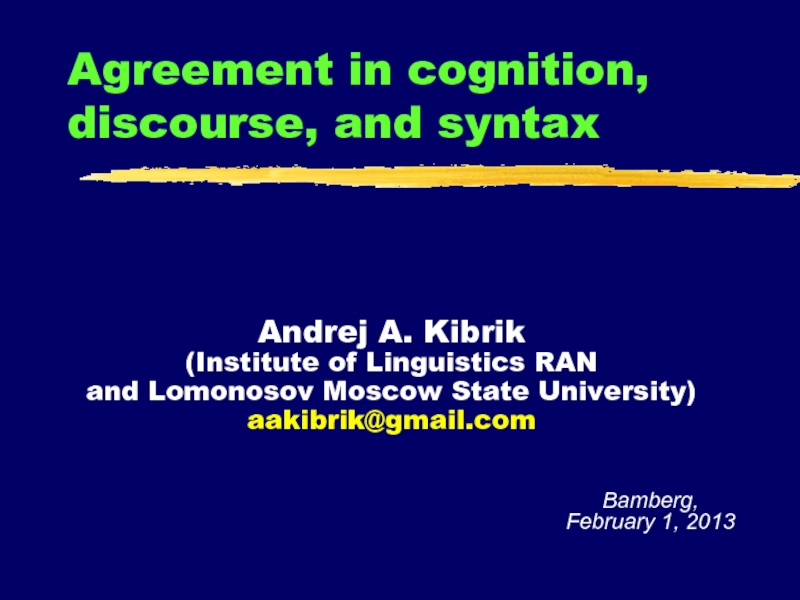

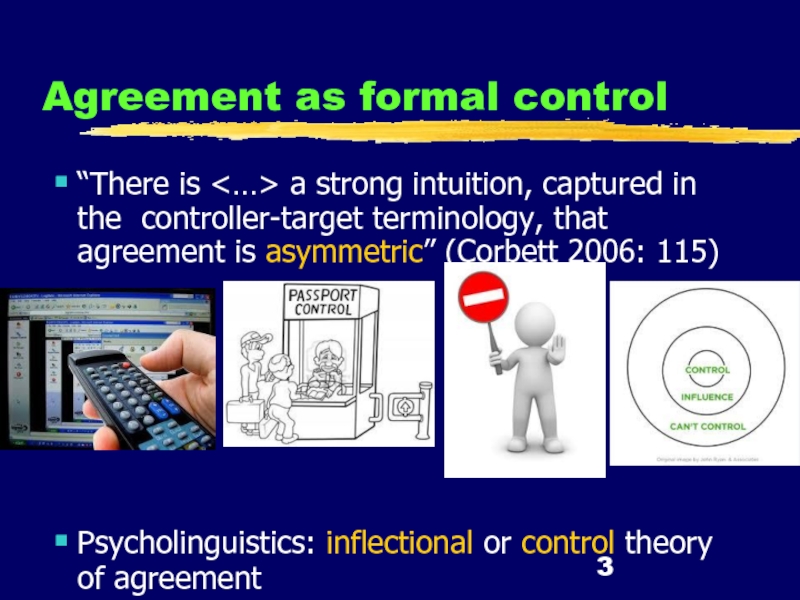
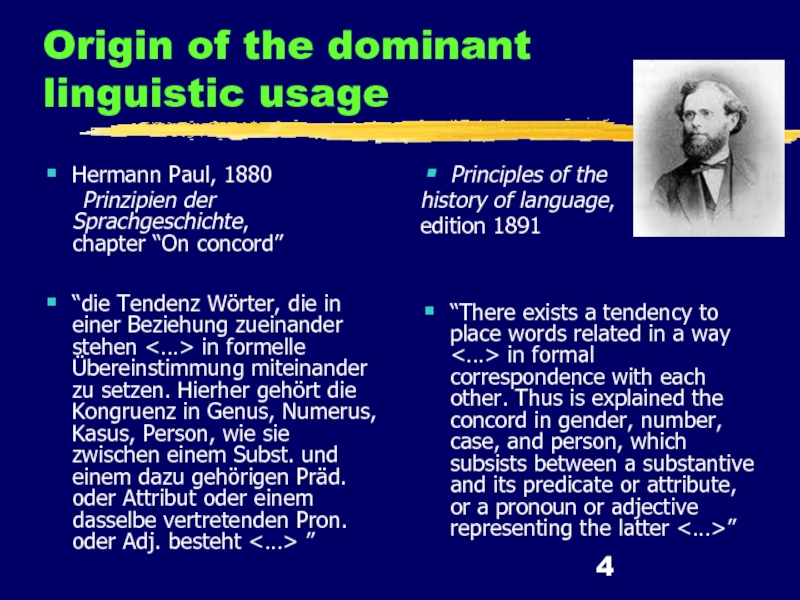
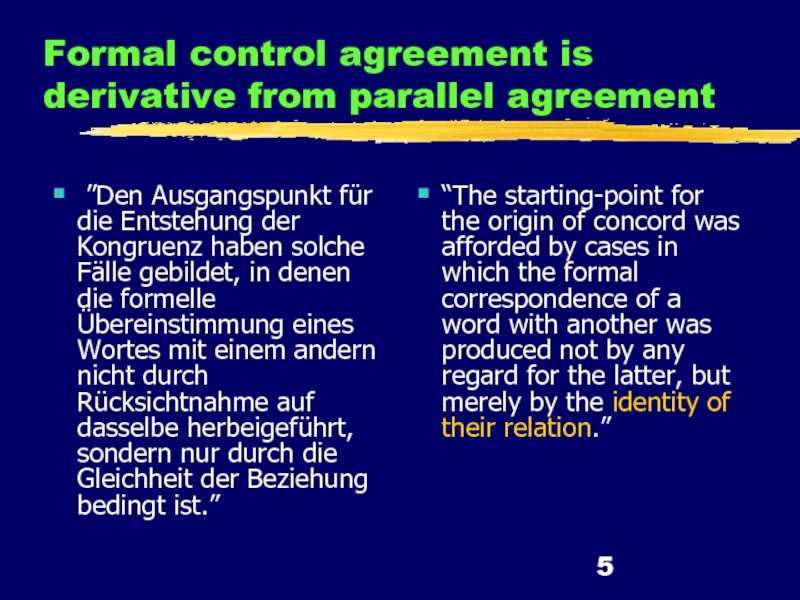
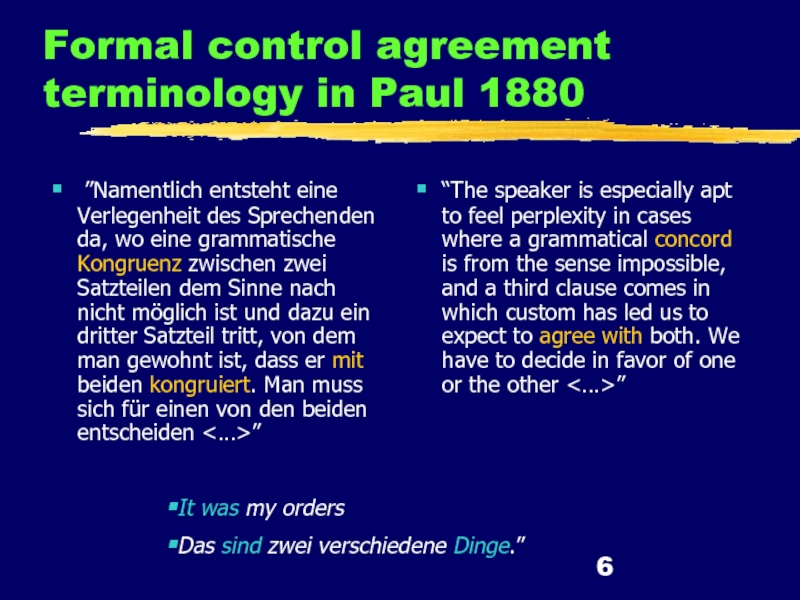
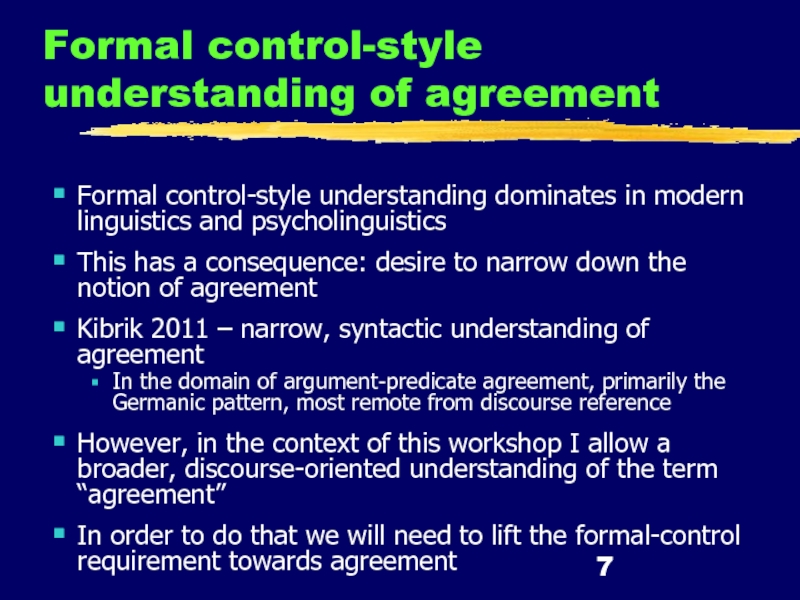

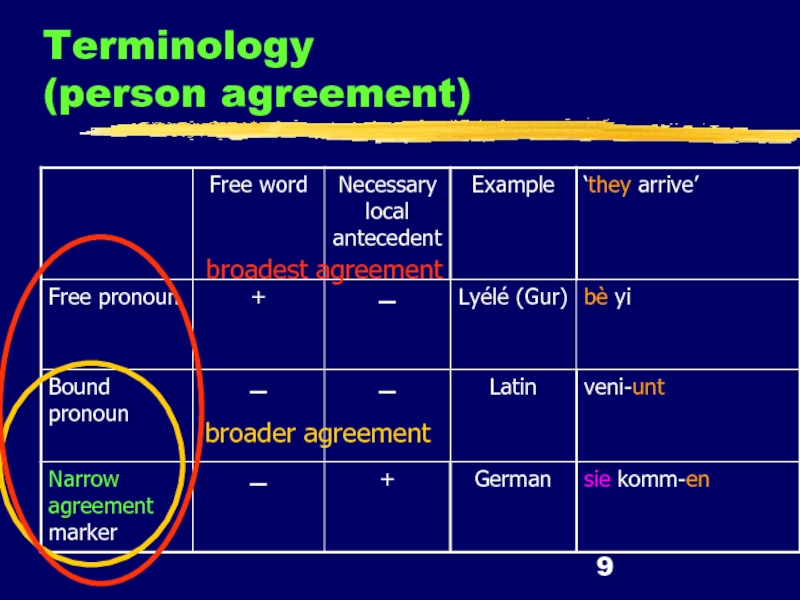
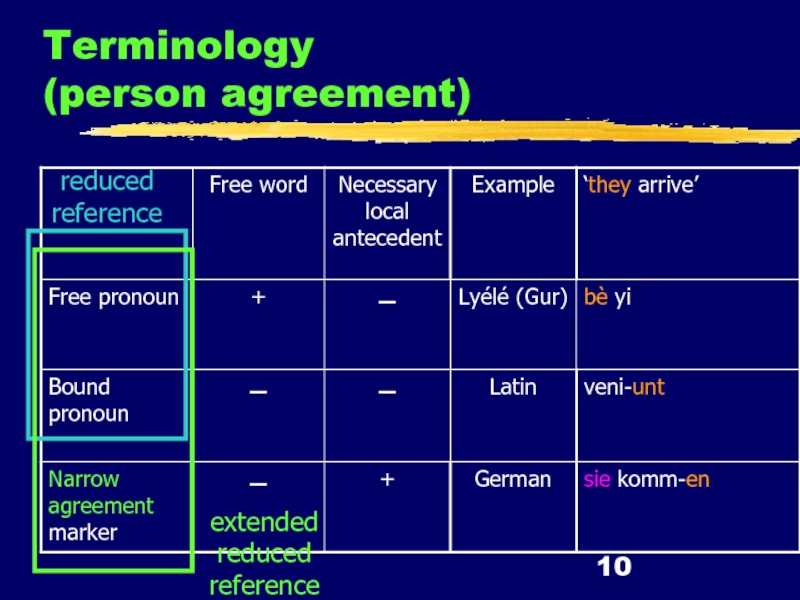
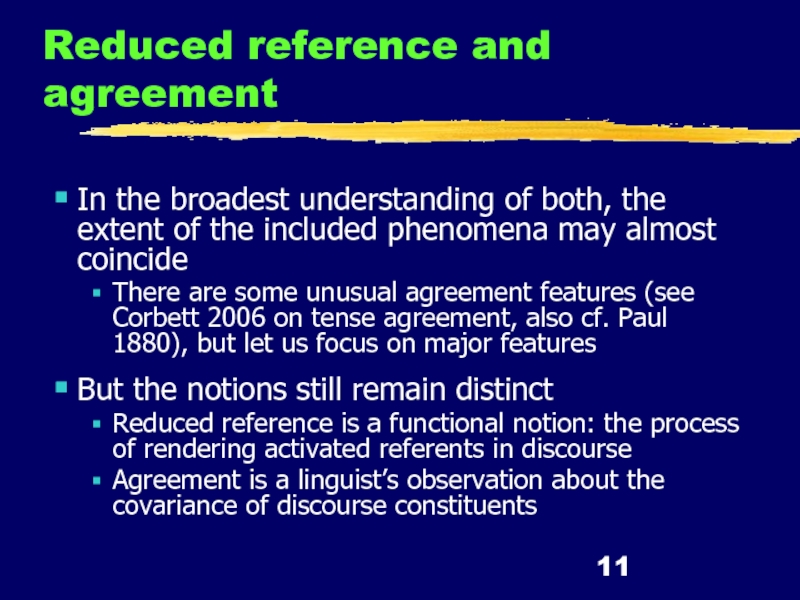
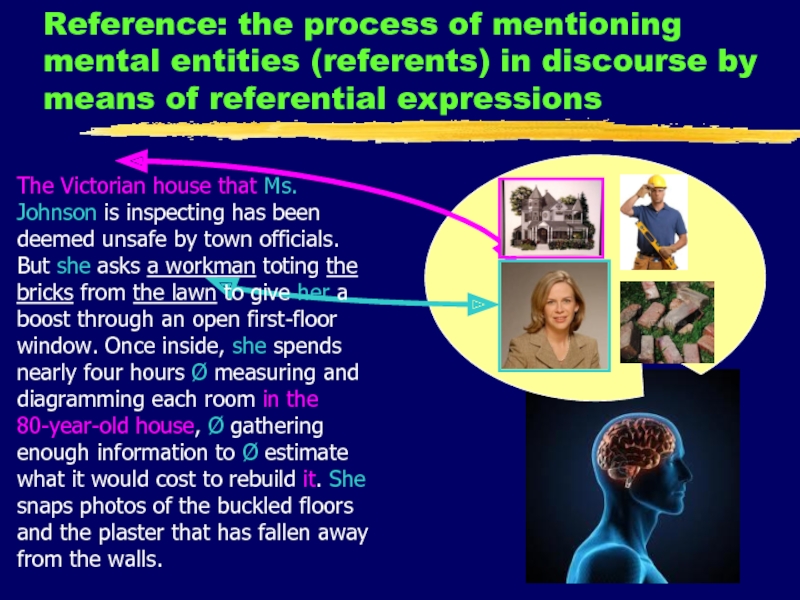
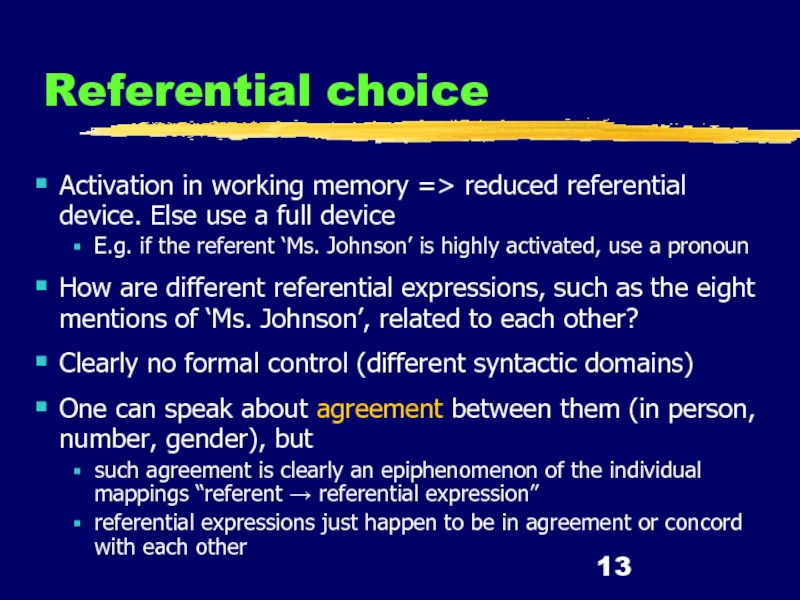
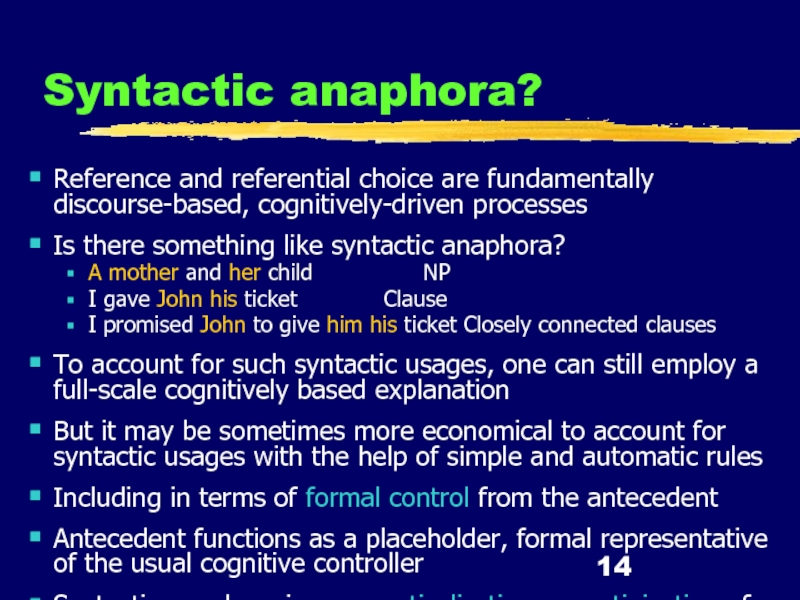
![Agreement in cognition, discourse, and syntax Discourse use of broader agreement (bound pronouns)Latin (Horace, Satires 1.5: 65 Discourse use of broader agreement (bound pronouns)Latin (Horace, Satires 1.5: 65 ff.)Cicirrus, Sarmentusrogaba-t denique cur umquam fugisse-t, ask.Impf-3Sg finally why sometime flee.Plpf.Conj-3Sgcui satis una farr-is libra fore-t, who.Dat enough one flour-Gen.Sg pound be.Impf.Conj-3Sg‘Finally he [=Cicirrus] asked](/img/thumbs/7370ed4a08bbf9d88e80e4e68ccaadb4-800x.jpg)
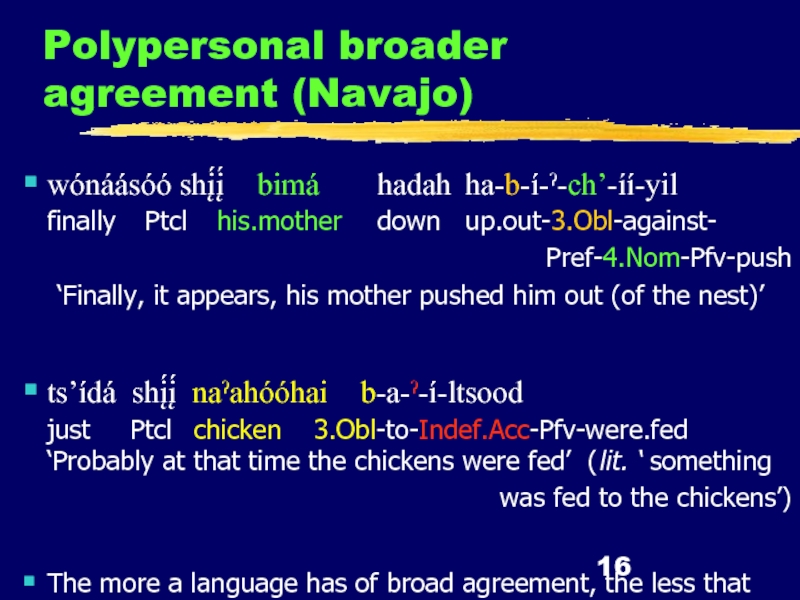
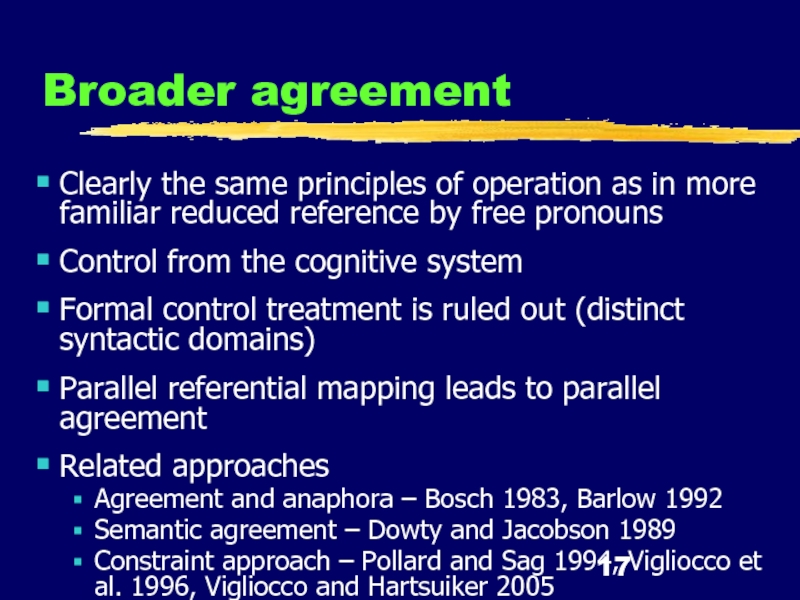
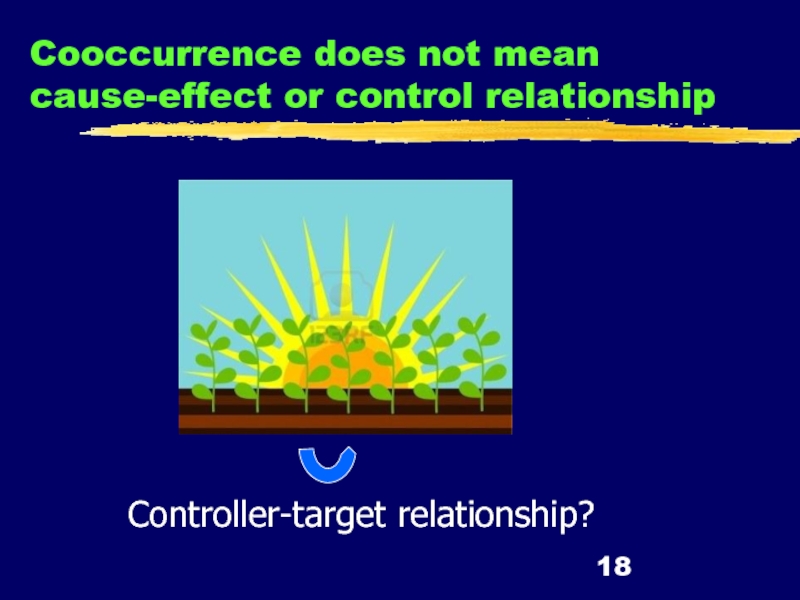
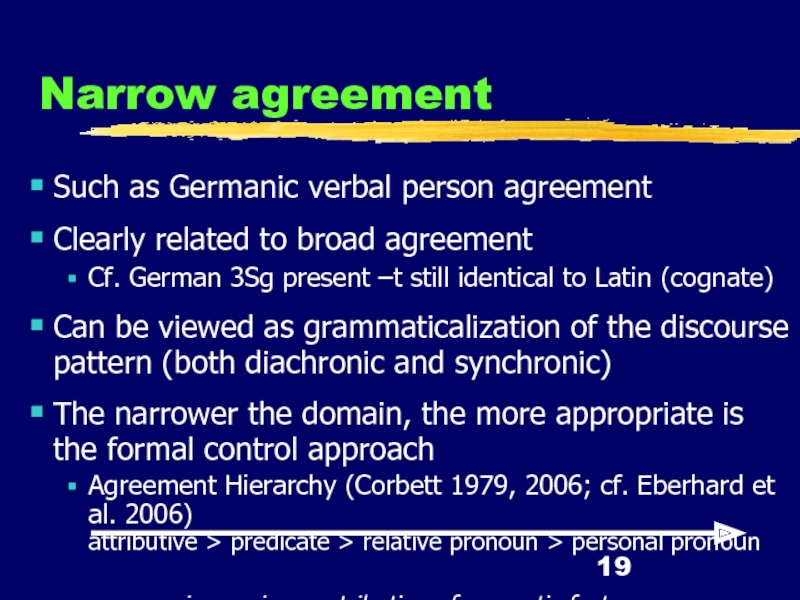

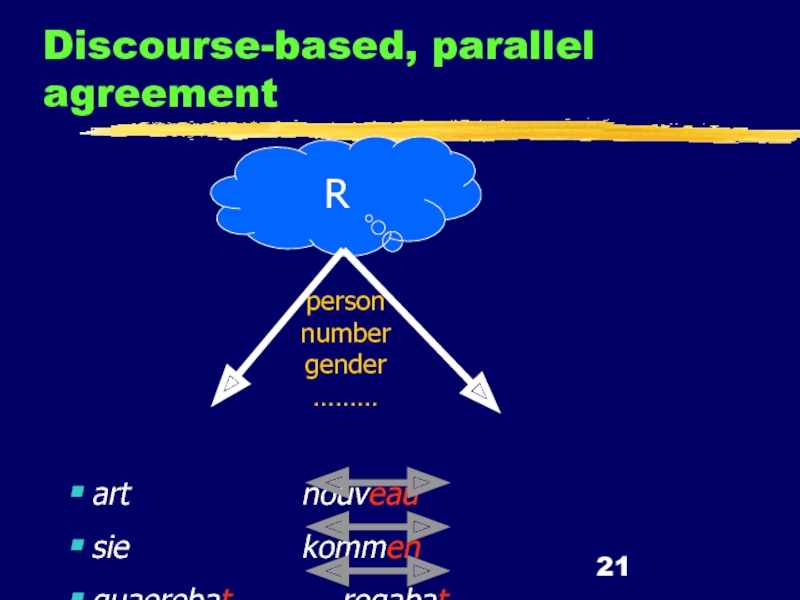

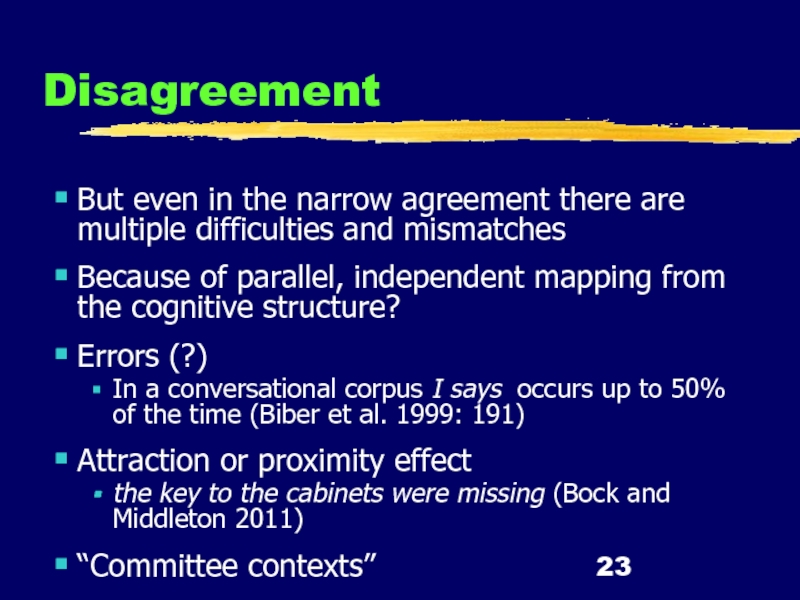
![Agreement in cognition, discourse, and syntax InconsistencyTurkic person agreementTuvan [men] keldim I comePast1Sg ‘I came’[men] kelgen=men I comePf=1Sg ‘I have come’ InconsistencyTurkic person agreementTuvan [men] keldim I comePast1Sg ‘I came’[men] kelgen=men I comePf=1Sg ‘I have come’](/img/thumbs/0c21abd623ae429697315ec0090cb65a-800x.jpg)
